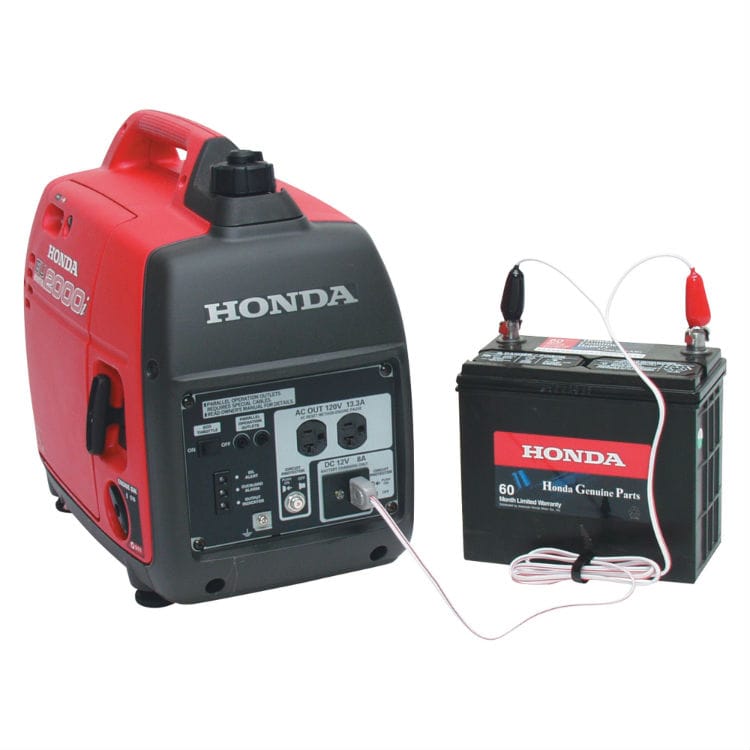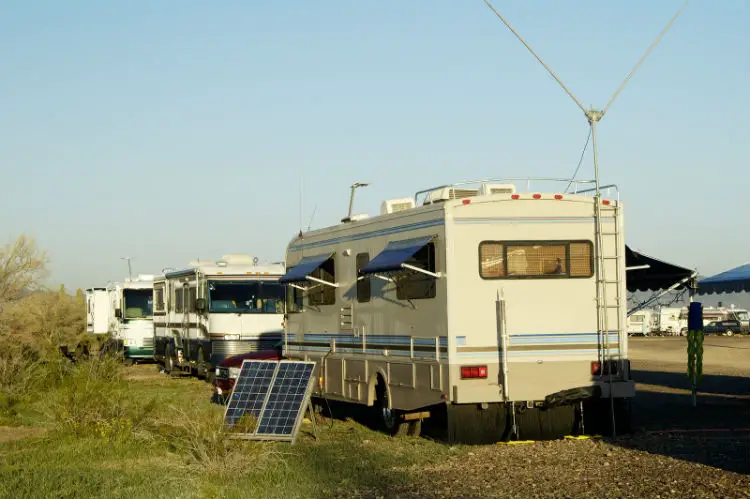As an RV owner and traveler, I want to make sure that we’ll enjoy our trips without hassle. Some of the problems we might face are a loss of water, flat tires, or loss of power.
So far, the worst thing that happened was that we couldn’t use the air conditioner because we were running low and we had no way to plug into a power source.
One time we went dry camping, and we were confident that we’ll have enough power. You see, we got the best RV generator, and we’ve had it for years now. Whenever we go somewhere, we make sure that our RV generator is fully charged so we can use it for emergency power supply.
RV living is a bit complicated but worthwhile. You just need to be responsible enough and make sure everything is in order before you travel.
In most cases, you can always go to a campground and plug into their power source. However, there are some instances that campgrounds are full, so it’s better to be well-prepared.

Via http://www.backwoodshome.com/an-89-dollar-backup-generator-by-jeffrey-yago/
In this article, I’d like to share with you some tips especially on how to charge the RV generator even while driving. I’ll also share with you other advice on how you can charge your RV battery.
More...
What To Do
Before charging up your RV battery, it is best to take some safety precautions by inspecting the battery and the electrical system. These safety practices ensure that you will not be harmed or your RV won’t be damaged. We shall also include battery inspection before charging to ensure added security.

Step-by-Step
Make sure that your generator is fully charged or plug it into an AC outlet.
Your RV should be turned off and the emergency brake engaged to avoid accidents.
Find out where the RV battery or batteries are located.

Via http://blog.wireandcableyourway.com/tag/welding-cable
Inspect the batteries for signs of bulging, cracks, and corrosion. If your battery terminals are dirty, proceed to the next step. Otherwise, skip to Step 8 .
Before cleaning the RV battery, use a wrench to remove the cables. Remove the black cable (negative) first before the red (positive) one.
Create a mixture of baking soda and water to create a paste.
Using a toothbrush, apply the paste to the battery terminals. Get a wire brush and remove the corrosions.
After all the grime has been removed, wipe it off with a clean rag and make sure the terminals are completely dry.
Apply petroleum jelly or a battery rust protector to the terminals.
Check the electrolyte levels and pour distilled water up to the fill point if the fluids are low.

Reconnect the RV battery by connecting the red (positive) cable first then the black (negative) one. Using a wrench, make sure they are securely fastened.
Unplug all electrical appliances to maximize charging. Turn off all lights as well.
If you can plug the generator into a 120V AC outlet, make sure it is plugged in. Otherwise, your generator should be fully charged.
Keep in mind that if you are using a portable generator with a 12V C output, charging will be very slow and may not fully charge your RV battery.
The charging time also depends on the weather. If it is below 40 degrees, you may not get the full capacity.
Plug your RV plug into the generator.
It may take up to 2 hours for the battery to full charge if it is not depleted, provided that the generator is plugged into an AC outlet. If your RV battery has dropped below 20%, it will take longer.
Make sure you don’t let your battery get depleted. Keeping the battery charged also extends its lifespan.

Via http://www.northerntool.com/shop/tools/product_200585498_200585498
After charging your RV battery with a portable generator, manage the use of your electrical appliances until you get to a campground.
Plug the generator as soon as you can for future use.
Other Methods of Charging
In case you don’t have a generator, there are still other ways to charge the RV battery. In fact, your alternator charges the RV battery. You may also want to read up on how to charge the RV battery while driving.
RV batteries are different from car batteries. The batteries in the RV couch are not connected to the engine’s alternator which charges a car’s battery when driving.
Here are other options to charge the RV battery:
Charging with Solar Panels

This method is the most efficient, yet expensive.
You need to purchase and install the solar panels on the roof of your RV.
The size of the solar panels depends on the amount of electricity you consume.
The solar panels are connected to the battery and inverter or charging unit to ensure continuous power source.
You also need to adjust the panels, so they face the sun.
Charging with a Converter
ou can charge deep-cycle batteries for your RV coach using a converter.
A converter, as the name suggests, converts 120V AC power into 12V DC.
However, this device is not an efficient charger. It can only provide an average of 40 amps, and charge your batteries at 3 to 5 amps.
Therefore, it will take you a long time to charge a depleted battery.
Using a Battery Charger

You can also purchase a separate battery charger specifically for your RV battery.
The RV battery charger is a portable device that has positive and negative clamps that you should directly connect to the battery.
To use this device, you need to disconnect the RV battery following step 5 above.
These portable battery chargers come with red and black jumper cables like those used to jumpstart a car’s battery. Connect the red clamps to the battery terminal, and the black clamp to a metal ground then switch on the charger.
Make sure that you completely charge the RV battery. An indicator light turns on when done.
After that, shut down the charger and remove the connections starting from the black clamp. Replace the battery connections following step 8 above.
Things to Remember
Apart from the safety tips mentioned above, here are a few details to help you maintain the lifespan of your RV battery and your electrical appliances.
- Your RV battery has different power requirements depending on size, converter output rating, amps, and battery discharge level. Make sure you know these specifications before purchasing a generator.
- Don’t let your RV batteries deplete to less than 20%; keep your battery charged to ensure its longevity.
- Inspect and clean your battery regularly. Always practice safety precautions when doing so. If you’re not comfortable, ask an expert to do it for you.
- Replace the RV batteries before they reach the expiration.
- Always have a voltmeter and/or polarity tester to test the connections before you plug into them. Fluctuating and unstable power sources are dangerous and can cause harm or injury.
- Manage the use of your electrical appliances so you can save on power.
- Make sure you have an understanding of basic electrical systems of your RV to help you troubleshoot issues and ensure safety.
- You should always have a backup power source in case of emergencies or when dry camping. Even if you have the best RV generator, you never know when your generator runs out of energy.
- Weather affects how long the RV battery lasts; it usually reduces its capacity in colder weather.
- Use a hydrometer and put on rubber gloves when checking the electrolyte levels of your battery. Refill only up to the filling point. RV batteries contain sulfuric acid that is toxic and causes serious injury when it comes in contact with your skin or clothing. You can also purchase maintenance-free batteries. They are quite expensive but worth it.
Conclusion
Your RV not only has one battery but two or more. The battery for the engine is different from the batteries that provide power to the coach.
To ensure that you’ll have a hassle-free RV living, be responsible enough to maintain the RV batteries. You may also need to purchase additional power sources such as solar panels, generators, chargers, or converters to power up your RV.
In instances wherein you need to plug into a campground, don’t be complacent and just plug into it. Practice safety by checking the voltage and making sure it is stable. However, don’t always rely on campgrounds because there may be many people connected and you won’t get the desired energy.
I hope that you found this article helpful. If you would like to share with us your tips and RV stories, please do so. We enjoy hearing from our readers.
Let us know if you have suggestions and feedback, too.
Don’t forget to share this article with others! Who knows? There may be someone you know who owns an RV or is planning to purchase one. They may find the tips helpful.
Enjoy camping!

Hi David, After reading your article, it appears you have a unique perception of RV battery charging, electrical systems and terminology. In the first section,”How to Charge RV Battery with Generator” it seems you’re describing a portable 12V power pack and calling it a “generator”. A generator is usually a gas powered unit such as the Honda EU2000i shown and does not require “charging” from a 120V AC outlet.
In the section “Charging with a Converter” you state, “this device is not an efficient charger”. This statement is incorrect. Whenever your RV is plugged in to a 120V AC source, the on-board converter is charging the on-board batteries as well as providing DC power to the water pump, lights etc.
In fact, most North American made RV’s and travel trailers are equipped with an IOTA DLS45 AC/DC Converter or similar. This is a very good converter/charger and IOTA now offers and add-on module, the “IQ4 Smart Charge Controller” for $36.00 CAD on Amazon. The IQ4 Smart Charge Controller simply plugs in to the DLS45 and provides automatic 4-stage charging; Bulk Charge, Absorption Charge, Float Charge and Maintenance Charge, providing longer battery life.
When Boon-docking, all you need to do is connect your RV’s shore-power cable to a gas inverter/generator to efficiently charge your batteries.
hi I have 72 volt electrical scooter .Can you help me to connect portable generator .in to my system while I m driving.thanks
“A converter, as the name suggests, converts 120V AC power into 12V DC.
However, this device is not an efficient charger. It can only provide an average of 40 amps, and charge your batteries at 3 to 5 amps.”
Umm.. what are you talking about?
If the converter is rated at 40amps, it could charge your battery at 40amp (minus some power loss due to the effiency of the converter) provided the AC input is at least 40amps. Whatever that input may be; shore power, generator.
The only other requirement would be that if the battery is sealed lead acid, that the battery capacity be high enough. I don’t remember the numbers, but due to the internal resistance of lead acid.. the charging rate is limited.
Lithium iron phosphate battery can usually handled at least 100 amps charge.
“A converter, as the name suggests, converts 120V AC power into 12V DC.
However, this device is not an efficient charger. It can only provide an average of 40 amps, and charge your batteries at 3 to 5 amps.”
Umm.. what are you talking about?
If the converter is rated at 40amps, it could charge your battery at 40amp (minus some power loss due to the effiency of the converter) provided the AC input is at least 40amps. Whatever that input may be; shore power, generator.
The only other requirement would be that if the battery is sealed lead acid, that the battery capacity high enough. I don’t remember the numbers, but due to the internal resistance of lead acid.. the charging rate is limited.
Lithium iron phosphate battery can usually handled at least 100 amps charge.